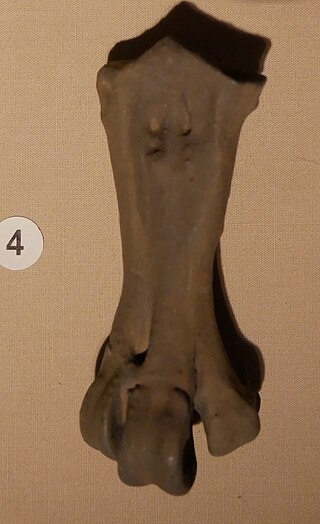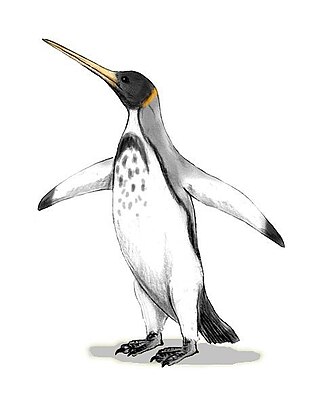
Penguins are a group of aquatic flightless birds from the order Sphenisciformes of the family Spheniscidae. They live almost exclusively in the Southern Hemisphere: only one species, the Galápagos penguin, is found north of the Equator. Highly adapted for life in the ocean water, penguins have countershaded dark and white plumage and flippers for swimming. Most penguins feed on krill, fish, squid and other forms of sea life which they catch with their bills and swallow whole while swimming. A penguin has a spiny tongue and powerful jaws to grip slippery prey.

Haast's eagle is an extinct species of eagle that lived in the South Island of New Zealand, commonly accepted to be the pouākai of Māori legend. It is the largest eagle known to have existed, with an estimated weight of 15 kilograms, compared to the next-largest and extant harpy eagle, at up to 9 kg (20 lb). Its massive size is explained as an evolutionary response to the size of its prey, the flightless moa, the largest of which could weigh 230 kg (510 lb). Haast's eagle became extinct around 1400, following the arrival of the Māori who hunted moa to extinction, introduced the Pacific rat, and destructed large tracts of forest by fire.

The Accipitridae is one of the three families within the order Accipitriformes, and is a family of small to large birds of prey with strongly hooked bills and variable morphology based on diet. They feed on a range of prey items from insects to medium-sized mammals, with a number feeding on carrion and a few feeding on fruit. The Accipitridae have a cosmopolitan distribution, being found on all the world's continents and a number of oceanic island groups. Some species are migratory. The family contains 255 species which are divided into 70 genera.

The mousebirds are birds in the order Coliiformes. They are the sister group to the clade Cavitaves, which includes the Leptosomiformes, Trogoniformes (trogons), Bucerotiformes, Piciformes and Coraciformes. This group is now confined to sub-Saharan Africa, and it is the only bird order confined entirely to that continent, with the possible exception of turacos which are considered by some as the distinct order Musophagiformes, and the cuckoo roller, which is the only member of the order Leptosomiformes, and which is found in Madagascar but not mainland Africa. Mousebirds had a wider range in the Paleogene, with a widespread distribution in Europe and North America during the Paleocene.

The genus Aptenodytes contains two extant species of penguins collectively known as "the great penguins".

Dromornis is a genus of large to enormous prehistoric birds native to Australia during the Oligocene to Pliocene epochs. The species were flightless, possessing greatly reduced wing structures but with large legs, similar to the modern ostrich or emu. They were likely to have been predominantly, if not exclusively, herbivorous browsers. The male of the largest species, Dromornis stirtoni, is a contender for the tallest and heaviest bird, and possibly exhibited aggressive territorial behaviour. They belong to the family Dromornithidae, extinct flightless birds known as mihirungs.

Waimanu is a genus of early penguin which lived during the Paleocene, soon after the Cretaceous–Paleogene extinction event, around 62–60 million years ago. It was about the size of an emperor penguin. It is one of the most important bird fossils for understanding the origin and evolution of birds because of the time period it comes from, and the position of penguins near the base of the bird family tree.

Paraptenodytes is an extinct genus of penguins which contains two or three species sized between a Magellanic penguin and an emperor penguin. They are known from fossil bones ranging from a partial skeleton and some additional material in the case of P. antarcticus, the type specimen for the genus, and a single humerus in the case of P. brodkorbi. The latter species is therefore often considered invalid; a recent study considers it indeed valid, but distinct enough not to belong into Paraptenodytes. The fossils were found in the Santa Cruz and Chubut Provinces of Patagonia, Argentina, in the Gaiman, Monte León and Santa Cruz Formations of Early to Middle Miocene age. Later occurrences are apparently from Late Miocene or possibly even Early Pliocene deposits.
Palaeeudyptinae, the giant penguins, is a paraphyletic subfamily of prehistoric penguins. It includes several genera of medium-sized to very large species, such as Icadyptes salasi, Palaeeudyptes marplesi, Anthropornis nordenskjoeldi, and Pachydyptes ponderosus. Icadyptes reached 1.5 m in height, while members of Palaeeudyptes and Anthropornis grew even taller and were some of the largest penguins to have ever existed. The massive P. ponderosus may have weighed at least as much as an adult human.

Palaeeudyptes antarcticus, also referred to as the narrow-flippered penguin, is the type species of the extinct penguin genus Palaeeudyptes. It was a huge species, albeit probably with a large size variation. Although the size range can only be loosely estimated, the birds seem to have stood between 43 and 55 inches high in life, placing this species and its congener Palaeeudyptes marplesi among the largest penguin species known. It was the last known Palaeeudyptes species, and although the exact time when it lived is not precisely determined, it may have evolved from P. marplesi, or they might even have been a single species which slightly decreased in size over time.
Paraptenodytes brodkorbi is a proposed, but possibly invalid, species of extinct penguin in the genus Paraptenodytes. The bird was probably about the size of a king penguin. Known material is limited to a single humerus, Early Miocene in age, found in the Monte León Formation near Puerto San Julián in Santa Cruz Province, Argentina. It exists as an unnumbered specimen in the collection of the Museo Argentino de Ciencias Naturales.

The Pelagornithidae, commonly called pelagornithids, pseudodontorns, bony-toothed birds, false-toothed birds or pseudotooth birds, are a prehistoric family of large seabirds. Their fossil remains have been found all over the world in rocks dating between the Early Paleocene and the Pliocene-Pleistocene boundary.

The evolution of the horse, a mammal of the family Equidae, occurred over a geologic time scale of 50 million years, transforming the small, dog-sized, forest-dwelling Eohippus into the modern horse. Paleozoologists have been able to piece together a more complete outline of the evolutionary lineage of the modern horse than of any other animal. Much of this evolution took place in North America, where horses originated but became extinct about 10,000 years ago, before being reintroduced in the 15th century.

Icadyptes is an extinct genus of giant penguins from the Late Eocene tropics of South America.

Pelagornis is a widespread genus of prehistoric pseudotooth birds. These were probably rather close relatives of either pelicans and storks, or waterfowl, and are placed here in the order Odontopterygiformes to account for this uncertainty.

Inkayacu is a genus of extinct penguins. It lived in what is now Peru during the Late Eocene, around 36 million years ago. A nearly complete skeleton was discovered in 2008 and includes fossilized feathers, the first known in penguins. A study of the melanosomes, pigment-containing organelles within the feathers, indicated that they were gray or reddish brown. This differs from modern penguins, which get their dark black-brown feathers from unique melanosomes that are large and ellipsoidal.

Kairuku is an extinct genus of penguin. It contains three species, K. grebneffi, K. waitaki and K. waewaeroa. This taxon is known from bones from 27 MYA, from the Kokoamu Greensand Formation of New Zealand. It was historically referred to as Palaeeudyptes.
Marplesornis novaezealandiae, also referred to as Harris's penguin, is a genus and species of extinct penguin from New Zealand. It was a relatively large penguin, about the same size as a king penguin. The age of the only known specimen is uncertain, being often mentioned as Late Pliocene in age. However, due to the complex geology of the collection site, its actual age is somewhere between Early Miocene and Late Pliocene.

Kumimanu is an extinct genus of giant penguin, which lived around 60 to 56 million years ago. The type species is K. biceae, which arose after the extinction of the non-avian dinosaurs. Fossils were found in New Zealand, and the discovery was announced in December 2017. A second species, Kumimanu fordycei, was named in February 2023.
Petradyptes is an extinct genus of penguin that lived during the Late Paleocene epoch, between 60 and 55 million years ago. The genus currently contains one known species, Petradyptes stonehousei.

















